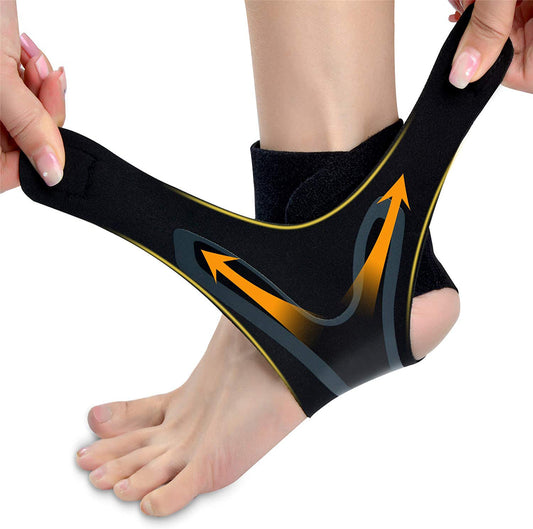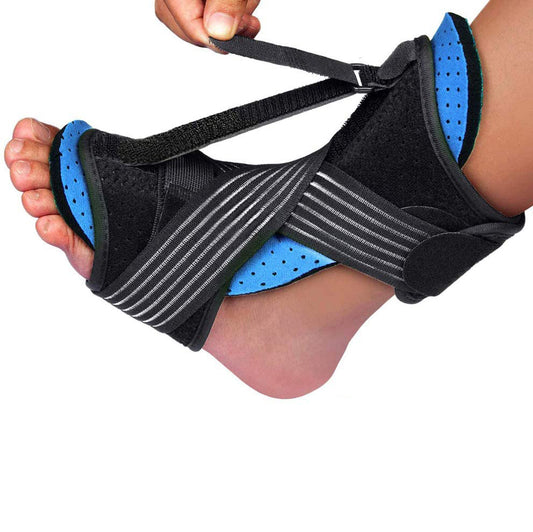-
Ankle Support Brace, Adjustable Ankle Brace with Breathable & Elastic Nylon Material, Comfortable Ankle Wrap Sports Protect Against Chronic Ankle Strain Sprains Fatigue
Regular price $13.99 USDRegular price$23.99 USDSale price $13.99 USDSale -
Ankle Brace, Lace Up Adjustable Support – for Running, Basketball, Injury Recovery, Sprain! Ankle Wrap for Men Women
Regular price $21.99 USDRegular price$21.99 USDSale price $21.99 USD -
Ankle Support Brace, Breathable Neoprene Sleeve, Adjustable Wrap
Regular price $15.99 USDRegular price$15.99 USDSale price $15.99 USD -
New Upgraded Night Splint for Plantar Fasciitis, Breathable and Adjustable Sleep Support Foot Drop Orthotic Brace for Plantar Fasciitis, Arch Foot Pain, Achilles Tendonitis Support for Women, Men
Regular price $32.99 USDRegular price$56.00 USDSale price $32.99 USDSale
Collection: Choosing the Right Ankle Brace for Sprain Recovery and Support
Maximize Your Performance and Recovery with Ankle Braces
Ankle braces have become a staple in sports and orthopedic recovery over the years. Whether you're an athlete looking to prevent injuries or someone recovering from an ankle sprain, these braces provide essential support and stability. This guide will help you understand who can benefit from an ankle brace, why you need one, how to choose the right type, and the features you should look for.
Why Ankle Braces Are Essential
Ankle braces are designed to minimize the risk of sprains by providing external support and limiting excessive movement. This is particularly vital for those who are active in sports that involve frequent running, jumping, or changes in direction, such as basketball, volleyball, and running.
Who Needs an Ankle Brace?
- Athletes and Sports Enthusiasts: Those engaged in high-impact sports can benefit from an ankle wrap designed for men and women.
- Individuals Recovering from Ankle Injuries: If you've recently suffered a sprain, an ankle brace can aid in recovery by stabilizing the area.
- Chronic Ankle Pain Sufferers: Those with conditions like chronic ankle strain or fatigue will find braces helpful in managing pain and preventing further strain.
How to Know If You Need an Ankle Brace
- Experience Regular Ankle Instability: If you often feel your ankle gives way under stress or during activities.
- Recovering from a Recent Injury: If an ankle injury is still bothering you, it may be time to wear a support brace to expedite healing.
- Engage in High-Impact Sports: Consider wearing a brace even if you haven't had an injury yet, particularly if you notice fatigue or minor discomfort.
Features to Look for in an Ankle Brace
When selecting an ankle brace, look for qualities that ensure comfort, durability, and effectiveness.
Key Characteristics
- Adjustable Fit: Look for braces like the adjustable ankle wrap that offers a customizable fit for optimal support.
- Material: Breathable neoprene or elastic nylon are popular for their comfort and flexibility.
- Ease of Use: Ensure the brace is easy to put on and adjust, preferably with lace-up or wrap-around designs.
Common Questions About Ankle Brace Use
Q: How tight should an ankle brace be?
A: It should be snug but not so tight as to cut off circulation. If your toes start tingling, it might be too tight.
Q: Can I wear an ankle brace all day?
A: You can, but it's generally recommended to wear it only during activities that put stress on the ankle. This allows your muscles to maintain strength when the brace isn't needed.
Q: How do I wash my ankle brace?
A: Most braces can be hand-washed with mild soap and water. Make sure to air dry them to maintain their elasticity and fit.
Why Choose Us for Your Ankle Support Needs?
We, at ZSZBACE, have extensive experience in crafting high-quality ankle braces. Our products are designed for maximum comfort and effectiveness, using the finest materials. Our breathable neoprene sleeve with an adjustable wrap is a testament to our commitment to quality. Plus, with our professional service and after-sales support, you can trust us for your recovery and performance needs.
Conclusion
Investing in a quality ankle brace allows you to enjoy immediate support for sprains, reduces risk during recovery, and enhances performance in sports. By understanding your specific needs and choosing the right features, like adjustable support and breathable materials, you can enhance your activity level while protecting your ankles from potential injuries. Whether you're an athlete, someone recovering from an injury, or looking to prevent future strains, our range of braces at ZSZBACE offers the perfect solution for you.




